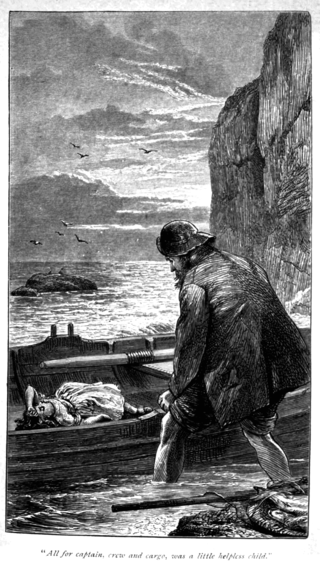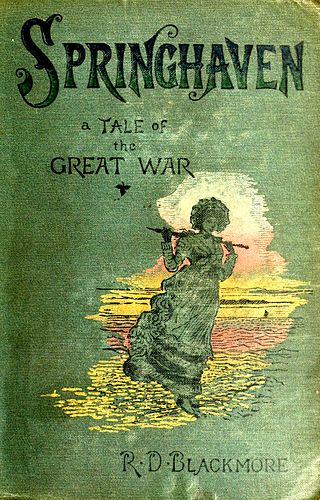
Hampton is a suburb of Greater London on the north bank of the River Thames, in the London Borough of Richmond upon Thames, England, and the historic county of Middlesex. Hampton is bounded by Bushy Park to the east, the suburbs of Hampton Hill and Fulwell to the north, green belt to the west, and the Thames to the south.

Richard Doddridge Blackmore, known as R. D. Blackmore, was one of the most famous English novelists of the second half of the nineteenth century. He won acclaim for vivid descriptions and personification of the countryside, sharing with Thomas Hardy a Western England background and a strong sense of regional setting in his works.

Sunbury-on-Thames is a town on the north bank of the River Thames in the Borough of Spelthorne, Surrey, England, 13 mi (21 km) southwest of central London. Historically part of the county of Middlesex, in 1965 Sunbury and other surrounding towns were initially intended to form part of the newly created county of Greater London, but were instead transferred to Surrey. Sunbury adjoins Feltham to the north, Hampton to the east, Ashford to the northwest and Shepperton to the southwest. Walton-on-Thames is to the south, on the opposite bank of the Thames.

Sir Walter Besant was an English novelist and historian. William Henry Besant was his brother, and another brother, Frank, was the husband of Annie Besant.

Thomas Knyvet, 1st Baron Knyvet was an English courtier and Member of Parliament who played a part in foiling the Gunpowder Plot.

Cripps the Carrier: a woodland tale, is a novel by Richard Doddridge Blackmore, author of Lorna Doone. It was first published in 1876 and is set in and around the village of Beckley in the rural area of Headington just outside Oxford to the east and the road to London.
John Heylyn was an Anglican divine, who had a major influence on religious thought in eighteenth century England. Because of his interest in mysticism he was known as the Mystic Doctor.

May Clark was an English silent film actress turned cinematographer. She played Alice in the 1903 film Alice in Wonderland, the first film adaptation of Lewis Carroll's 1865 children's book Alice's Adventures in Wonderland.

Florence Henniker was a British poet and novelist.

Cradock Nowell: a tale of the New Forest is a three-volume novel by R. D. Blackmore published in 1866. Set in the New Forest and in London, it follows the fortunes of Cradock Nowell who is thrown out of his family home by his father following the suspicious death of Cradock's twin brother Clayton. It was Blackmore's second novel, and the novel he wrote prior to his most famous work Lorna Doone.

The Maid of Sker is a three-volume novel that was written by R. D. Blackmore and published in 1872. The novel is set in the late 18th century and is about an elderly fisherman who unravels the mysterious origins of a foundling child who is washed ashore on the coast of Glamorganshire, South Wales. It was published subsequent to Blackmore's Lorna Doone, although he had begun writing The Maid of Sker 25 years earlier. Blackmore considered The Maid of Sker to be his best novel.

Springhaven: a tale of the Great War is a three-volume novel by R. D. Blackmore published in 1887. It is set in Sussex, England, during the time of the Napoleonic Wars, and revolves around the plots of the villainous Captain Caryl Carne who attempts to aid a French invasion.

Christowell: a Dartmoor tale is a three-volume novel by R. D. Blackmore published in 1882. It is set in the fictional village of Christowell on the eastern edge of Dartmoor.

Mary Anerley: a Yorkshire tale is a three-volume novel by R. D. Blackmore published in 1880. It is set in the rugged landscape of Yorkshire's North Riding and the sea-coast of its East Riding.

Erema; or, my father's sin is a three-volume novel by R. D. Blackmore published in 1877. The novel is narrated by a teenage girl called Erema whose father escaped from England having been charged with a murder he did not commit. Erema has grown up in exile with her father, and the story begins in California in the 1850s.

Dariel: a romance of Surrey is a novel by R. D. Blackmore published in 1897. It is an adventure story set initially in Surrey before the action moves to the Caucasian mountains. The story is narrated by George Cranleigh, a farmer who falls in love with Dariel, the daughter of a Caucasian prince. Dariel was the last of Blackmore's novels, published just over two years before his death.

Perlycross: a tale of the western hills is a three-volume novel by R. D. Blackmore published in 1894. The story is set in eastern Devon around 1830.

The Upper Flask was a tavern near the top of Hampstead hill in the 18th century which sold flasks of water from the spa at Hampstead Wells. It was located in Heath Street. It was the summer meeting place of the great literary and political figures of the Kit-Kat Club such as Walpole. The tavern business ceased in the 1750s and the grand house subsequently became the private residence of ladies and gentlemen such as Lady Charlotte Rich, George Steevens and Thomas Sheppard.
Elizabeth Whately was an English writer and the wife of Dr Richard Whately, Protestant Archbishop of Dublin. She wrote and edited a number of fictional, religious and educational works, although little of her writing appeared explicitly under her own name.
Catharine, or the Bower is an unfinished novel from Jane Austen's juvenilia. With its realistic setting and characters, it represents something of a bridge between her early burlesques and the soberer novels that made her name.

















